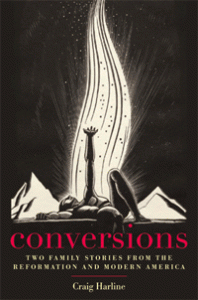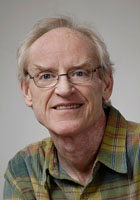Book Review: “Conversions: Two Family Stories from the Reformation and Modern America”
Harline has taken the time to notice and understand that the coming out process for the gay man is parallel to the experience on both the individual and the family and social circles of the religious convert
Gerald S. Argetsinger, Ph.D.
Rochester Institute of Technology
October 2011
Conversions: Two Family Stories from the Reformation and Modern America. Craig Harline. New Haven: Yale University Press, 2011. (301+xi pages)
I picked up Conversions: Two Family Stories from the Reformation and Modern America by Craig Harline Saturday, thinking it would take close to a week to give it a thoughtful read. I finished it Sunday. I cannot remember the last time I was unable to put down an “academic book.” What an unexpected joy! Craig Harline, a BYU history professor, has written a compelling, insightful examination on the unlikely topic of “conversion.” Much of its success
lies in Harline’s unorthodox approach, intertwining two family stories, one beginning in 1650’s Holland and the other in 1970’s California, in the style of narrative history. His perceptive commentary on the impact of the conversion process flows naturally from the similarities of the experiences of the converting individuals, their immediate families and their social circles. As an outgrowth of the modern story, he also discusses homosexuality and how coming out mirrors the religious conversion process.
Harline begins in The Netherlands with the tale of Jacob Rolandus, the twenty-one year old son of a prominent Protestant minister who secretly converts to Catholicism, escaping from his family and friends to live near the Jesuits in Antwerp. The second tale skips ahead three hundred years to California, recounting the life of Michael Sunbloom (a pseudonym) who converted from Evangelical Protestantism to Mormonism. Michael was extremely popular and succeeded wildly in everything he did. His conversion occurred just after graduating from college and he threw himself into his new religion, soon becoming the most successful leader in the Mormon Young Single Adults program in the history of California. On his twenty-sixth birthday Michael was released from leadership and instructed to assimilate into a family-centered congregation. Instead, Michael unexpectedly disappeared . . . for decades. As the stories progress, Harline develops themes and commentary based on thorough research and insights into the “conversion process.” He considers, for example: What experiences bring an individual to the point of considering such a life altering decision as conversion? What happens when the actual conversion occurs? What is the effect of that conversion on the heart-broken family and social circle(s) left behind who ask themselves what they did wrong? And of particular significance to Mormons, what happens to the individual after the conversion takes place?
Even though the lives and times of Jacob and Michael are so unique and varied, Harline discovers transhistorical significance. Jacob ultimately finds fulfillment in a mission to the jungles of Brazil, personally experiencing the horrors immediately preceding those depicted in the movie The Mission (script: Robert Bolt; direction: Roland Joffé – 1986). When Michael resurfaced, he had been secretly trying to reconcile his newly found Mormonism with his also newly recognized homosexuality. Michael did not recognize his homosexuality until he was around twenty-five and it scared him to death. When he was released from the Young Adult Program leadership, he also quit his teaching job and left “to find himself.” Ultimately, he converted out of Mormonism and into a monogamous gay relationship.
So there are four conversion stories: Jacob Rolandus from Protestant to Catholic and Michael Sunbloom from Evangelical to Mormon, then to accepting his homosexuality, and finally out of Mormonism.
One of the most important aspects of Conversions is Harline’s inclusion of the disruption the conversions cause in the families and social circles of the converts. Not only is conversion hard work, but rejection and assimilation are equally difficult. No one is left unscarred.
Of particular note is that Harline, a believing Mormon and professor at Brigham Young University, has taken the time to notice and understand that the coming out process for the gay man is parallel to the experience on both the individual and the family and social circles of the religious convert. Harline presents one of the best examinations of a young man discovering his unwanted (at first) homosexuality as a young Mormon. He then lays all of the cards on the table regarding homosexuality and the Mormon church — and he gets it right. Harline neither condemns nor waves a rainbow flag, he just examines the facts and discovers the truths of the issue. Finally, after illuminating the present with perceptions of the past, he turns to the past to ask what could have happened differently, in effect turning the present onto the historic. He discusses how families could do one of three things: reject, muddle along as best they can, or accept the conversion. With this he discusses the difference between the alienation and reconciliation experiences. Harline examines how “truth” is perceived by different experiences and viewpoints, each person believing their own lens as “The True” lens. He then describes how families can only survive conversion experiences by developing “new cognitions” that allow them to accept differences and that differences cannot be dismissed merely because they do not agree with someone’s personal beliefs.
Conversions is a book that should be read by every Mission President and General Authority in the Mormon Church. At a time when barely 20% of newly baptized converts remain active in the Church (because baptism is often seen as the culmination of the conversion instead of as the beginning of a process that will take up to five years to complete), the vital social/family aspects of change are typically ignored because they are at worst unknown or at best never discussed.
In the Postscript, Harline discusses the hesitations that troubled him as he considered juxtaposing the lives of such historically different individuals and situations finding psychological sameness instead of otherness. He wondered, “Would a gay person find it of interest?” The answer is a resounding, “Yes!” It is a perspective that provides insight that could lead to a more tranquil and positive coming out experience. Conversions is a journey well worth taking.

